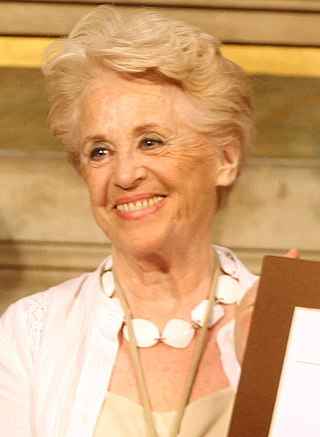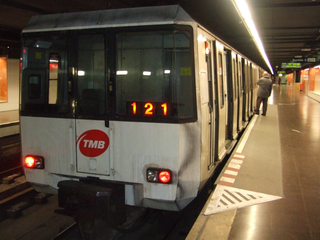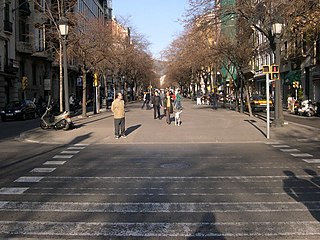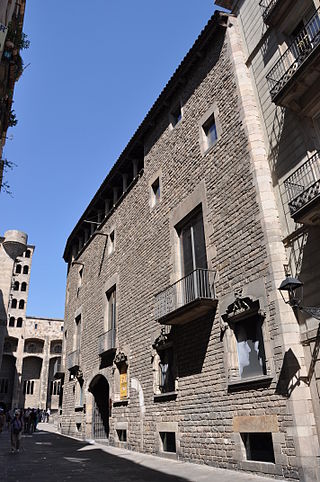
Sabadell is a city in Catalonia, Spain. It is in the south of the comarca of Vallès Occidental and its joint capital (co-capital), on the River Ripoll, 20 km (12 mi) north of Barcelona. Sabadell is located 190 m (620 ft) above sea level.

The Barcelona Metro is a network of rapid transit electrified railway lines that run mostly underground in central Barcelona and into the city's suburbs. It is part of the larger public transport system of Barcelona, the capital of Catalonia, Spain, with unified fares under the Autoritat del Transport Metropolità (ATM) scheme. As of 2014, the network is operated by two separate companies: Transports Metropolitans de Barcelona (TMB) and Ferrocarrils de la Generalitat de Catalunya (FGC). It is made up of 12 lines, combining the lines owned by the two companies. Two lines, L9 and L10, are being built at present, with both lines having different sections of each opened between 2009 and 2018. They are due to be fully completed in 2026. Three lines on the network have opened as automatic train operation/driverless vehicle systems since 2009: Line 11 being converted to driverless first, and then Lines 9 and 10, opening up driverless.

Montserrat Carulla i Ventura was a Spanish actress.

The Montjuïc Funicular is a funicular railway in the city of Barcelona, in Catalonia, Spain. The railway mainly runs through a tunnel and connects the Barcelona Metro's Paral·lel station with the hill of Montjuïc and the various sporting facilities and other attractions there.

Passeig de Gràcia is one of the major avenues in Barcelona (Catalonia) and one of its most important shopping and business areas, containing several of the city's most celebrated pieces of architecture. It is located in the central part of Eixample, stretching from Plaça Catalunya to Carrer Gran de Gràcia.

Line 1, shortened to L1, coloured red and often simply called Línia vermella, is the second oldest Barcelona Metro line, after line L3. It is the longest line of the Barcelona Metro, and links L'Hospitalet de Llobregat and Santa Coloma de Gramenet. Originally operated by the independent Ferrocarril Metropolitano Transversal de Barcelona, it is today operated by Transports Metropolitans de Barcelona (TMB) and is part of the ATM fare-integrated main transport system. L1 is the only metro line in Spain to use Iberian gauge tracks, as used by most Spanish main line railways.

Line 9 is a completely automated line of the Barcelona Metro network that is currently under construction, with 24 stations open in Barcelona and El Prat de Llobregat, L'Hospitalet de Llobregat, Badalona and Santa Coloma de Gramenet suburbs, since December 2009. The line is currently disconnected in two branches, with a connecting part between the two yet to be built. The Aeroport T1 – Zona Universitària section is called L9 South, and the La Sagrera – Can Zam portion L9 North. Upon completion, it will be the longest underground metro line in Europe.

Hospital de Bellvitge, formerly known as Feixa Llarga, is a Barcelona Metro station, in the L'Hospitalet de Llobregat municipality of the Barcelona metropolitan area, and named after the nearby Bellvitge University Hospital. The station is the western terminus of line L1.

Avinguda Diagonal is the name of one of Barcelona's broadest and most important avenues. It cuts the city in two, diagonally with respect to the grid pattern of the surrounding streets, hence the name.

Rambla de Catalunya is a major street in the Eixample district of central Barcelona, Spain. It is one of the city's trendiest streets, with many international fashion shops, and is lined with lime trees.

Parc de la Creueta del Coll is a park in the Gràcia and Horta districts of Barcelona, Catalonia, Spain. The park was created from an abandoned quarry as part of the nou urbanisme developments during the 1992 Summer Olympics by architects Martorell, Bohigas and Mackay.

Plaça d'Espanya, also simply known as Espanya, is an interchange complex underneath Plaça d'Espanya, in the Barcelona district of Sants-Montjuïc, in Catalonia, Spain. It comprises the Barcelona terminus of the Llobregat–Anoia Line and a Barcelona Metro station complex served by lines 1 (L1) and 3 (L3). On the L1, the station is between Hostafrancs and Rocafort, and on the L3 it is between Poble Sec and Tarragona. The Llobregat–Anoia Line station is served by Barcelona Metro line 8 (L8), Baix Llobregat Metro lines S33, S4 and S8, and commuter rail lines R5, R6, R50 and R60. The services on the Llobregat–Anoia Line are operated by Ferrocarrils de la Generalitat de Catalunya (FGC), whilst the L1 and L3 are operated by Transports Metropolitans de Barcelona (TMB).

Via LaietanaVía Layetana in Spanish, is a major thoroughfare in Barcelona, Catalonia, Spain, in the Ciutat Vella district. The avenue runs from Plaça Urquinaona to Plaça d'Antonio López, by the seafront, and separates the neighbourhoods of the old city it has on either side: La Ribera/El Born and Sant Pere on one and Barri Gòtic on the other. Besides being always overcrowded with both locals and tourists attracted by its Modernista Art Nouveau, Art Déco, and Noucentista neo-classical architecture, in addition to its nearness to the Ramblas and the quiet pedestrian streets of Barri Gòtic, Via Laietana hosts the headquarters of a number of banks and institutions.

Vall d'Hebron | Sant Genis is a Barcelona Metro station, in the Horta-Guinardó district of Barcelona, and named after the nearby Vall d'Hebron neighbourhood. The station is served by line L3 and is the northern terminus of line L5.

Gorg is a Barcelona Metro and Trambesòs complex named after the neighbourhood of the same name where the station is situated, in Badalona municipality. It is located on Avinguda del Marquès de Mont-Roig and very close to Palau Municipal d'Esports de Badalona, the home arena of the professional basketball club Joventut de Badalona. It is served by TMB-operated Barcelona Metro lines L2 and L10, and Trambesòs route T5.

Airport T2 is both a Rodalies de Catalunya commuter rail station and a Barcelona Metro station serving terminal complex T2 of Barcelona–El Prat Airport. They are located adjacent to the airport's terminal T2B, in the municipality of El Prat de Llobregat, to the southwest of Barcelona, in Catalonia, Spain. The Rodalies de Catalunya station is the southern terminus of the current rail link coming from El Prat de Llobregat railway station. It is operated by Renfe Operadora and is served by Barcelona commuter rail service line R2 Nord. The metro station is on the airport branch of Barcelona Metro line 9 (L9) and is operated by Transports Metropolitans de Barcelona (TMB).

Mishima is a Catalan indie pop band from Barcelona, Spain. Formed in 1999, the band consists of David Carabén, Marc Lloret, Dani Vega, Xavi Caparrós, and Alfons Serra. The group's name refers to Japanese author Yukio Mishima.

The Museum of the History of Barcelona is a history museum that conserves, researches, communicates and exhibits the historical heritage of the city of Barcelona, from its origins in Roman times until the present day. The museum's headquarters are located on Plaça del Rei, in the Barcelona Gothic Quarter. It also manages several historic sites all around the city, most of them archaeological sites displaying remains of the ancient Roman city, called Barcino in Latin. Some others date to medieval times, including the Jewish quarter and the medieval royal palace called the Palau Reial Major. The rest are contemporary, among them old industrial buildings and sites related to Antoni Gaudí and the Spanish Civil War.

Airport T1 is a Barcelona Metro station that serves terminal T1 of Barcelona–El Prat Airport, in the municipality of El Prat de Llobregat, to the southwest of Barcelona. It is the southern terminus of the airport branch of Barcelona Metro line 9 (L9) and is operated by Transports Metropolitans de Barcelona (TMB).




















